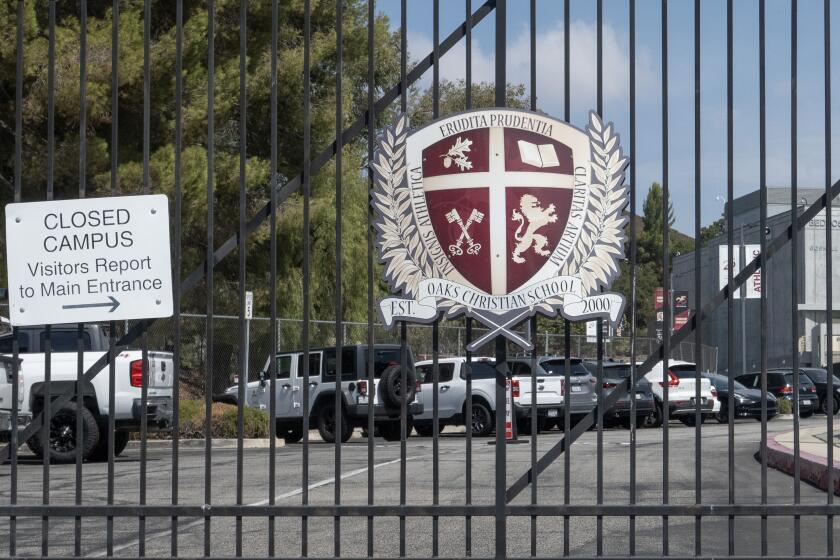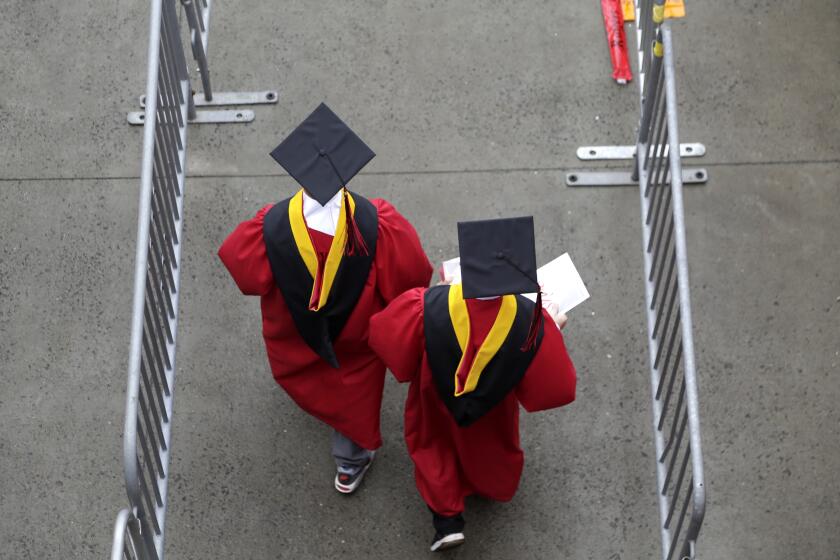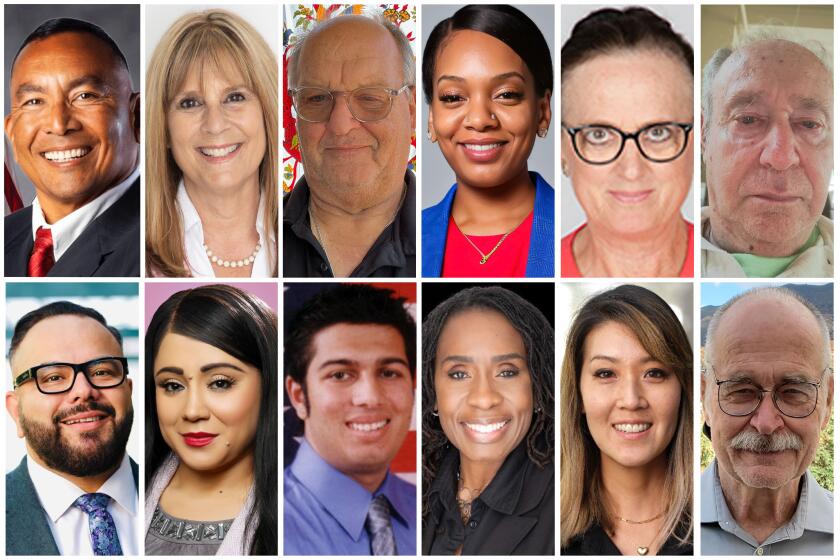HIGH LIFE: A WEEKLY FORUM FOR HIGH SCHOOL STUDENTS : A Sense of Seeing : Braille Institute’s Staff Leads Students to a Life of Independence
The garden is beautiful.
The irony is that the people for whom the garden exists cannot see it. They are legally blind and are students at the Orange County Center of the Braille Institute in Anaheim.
But just because these students can’t see the flowers doesn’t mean that they can’t observe their beauty. They can sense beauty that sighted people often can’t perceive.
The adolescents program at the Braille Institute is made possible by three groups of people: the students, the volunteers and the coordinators.
“We rely heavily on our volunteers,” said Steve Schuyler, the Braille Institute’s youth coordinator.
There are about 55 registered volunteers who help at activities and functions throughout the year. In addition, there are special groups of volunteers from various clubs who donate their time for special events, Schuyler said.
During the school year, the program primarily focuses on independent living skills (ILS). These weekly classes help the blind students learn to accomplish the tasks necessary to become more independent.
“In the ILS classes, we try to create a one-to-one ratio between volunteers and the students,” Schuyler said. “And in it, the volunteers do the actual teaching.”
In the ILS classes, students learn ways to help them identify paper money, such as folding different denominations in different ways. They also learn to cook their own meals and tie their own shoelaces.
“Tying shoelaces is so difficult because they (the blind) can’t see where the ends are, and so it’s hard for them to distinguish one end from the other,” Schuyler said.
Other activities during the year include rock climbing, ski and camping trips, and other outdoor events.
“River-rafting down the Colorado River was the best trip we ever took. We ate really well and even though we didn’t go in the rapids, it was really great,” said Kellie Walders, a 16-year-old junior at Fountain Valley High School. Walders, who has been legally blind since birth, has been a student of the Braille Institute since she was 5.
“I don’t think it’s sad that I’m not able to see everything,” she said. “But the people treat me differently. Actually, I’m good at those things because I can laugh at it. If they saw themselves act the way they do (toward blind people), they’d probably be real embarrassed.
“A lot of people literally think that we cannot function as human beings. They think since we’re blind that we’re deaf, too. That’s a real common misconception.”
Kellie explained that it is sometimes difficult to cope with stereotypes at school.
“With the sighted people in school, it’s like no one can be different from anyone else,” she said. “But with us (the blind students), it’s OK to be different because we are different. I think that’s good because we’ve learned to accept people as they are.”
Kellie hopes to someday become a novelist.
During the summer, the institute’s program for teen-agers includes daily, fun-oriented activities. They organize everything from roller-skating to trips to Wild Rivers water park; from scavenger hunts on Balboa to visiting a recording studio, and from windsurfing to tandem bike-riding.
“It’s great watching the blind kids do things normal kids do and see them doing things you don’t think they can do,” said volunteer Brandon Marumoto, a 17-year-old senior at La Quinta High School. “Roller-skating, for instance. How often do you see blind kids roller-skate?
“When you see a blind person, instead of feeling sorry for them, you should respect them for all the things they can do.”
Mari Sanchez, blind since birth, has attended classes at the Braille Institute since she was 5. She is a 15-year-old sophomore at Bolsa Grande High School.
Mari, who can read material with very large print, said: “It’s frustrating to go into a restaurant and not be able to read the menu and have to guess what they may have. I would love to read small writing without a magnifying glass.”
Schuyler said only a small percentage of the 152 students enrolled in the Braille program are totally blind. Most can see shadows, figures or even, as in the case of Mari, large print. Mari said: “I help people who are totally blind at Braille. Helping them makes you feel useful and needed.
“The faculty at Braille made me an independent person, and they taught me to speak for myself,” said Mari, who sings for her school choir and hopes for a music career someday.
Volunteer Erica Guerra, an 18-year-old sophomore at Stanford, said: “Ever since I saw Mary (a blind girl) on ‘Little House on the Prairie,’ I’ve wanted to work for Braille Institute. . . . If I couldn’t see, I would be so helpless, but they (the students) make up for it in so many other ways. They’re very independent.” Guerra graduated from Connelly High School in 1988.
“Don’t assume they are helpless. The only limitations (blind people) have are the ones sighted people give them.”
Greg Weins, 16, has been legally blind since birth and has been in the Braille Institute’s program since he was 7. The sophomore at Fountain Valley High School hopes to become a professional keyboard player someday.
“I play music all by ear,” he said.
Schuyler emphasized the importance of the program’s volunteers. “If everyone in the country volunteered as much as our volunteers do, its significance would be hard to imagine,” he said.
More to Read
Sign up for Essential California
The most important California stories and recommendations in your inbox every morning.
You may occasionally receive promotional content from the Los Angeles Times.










